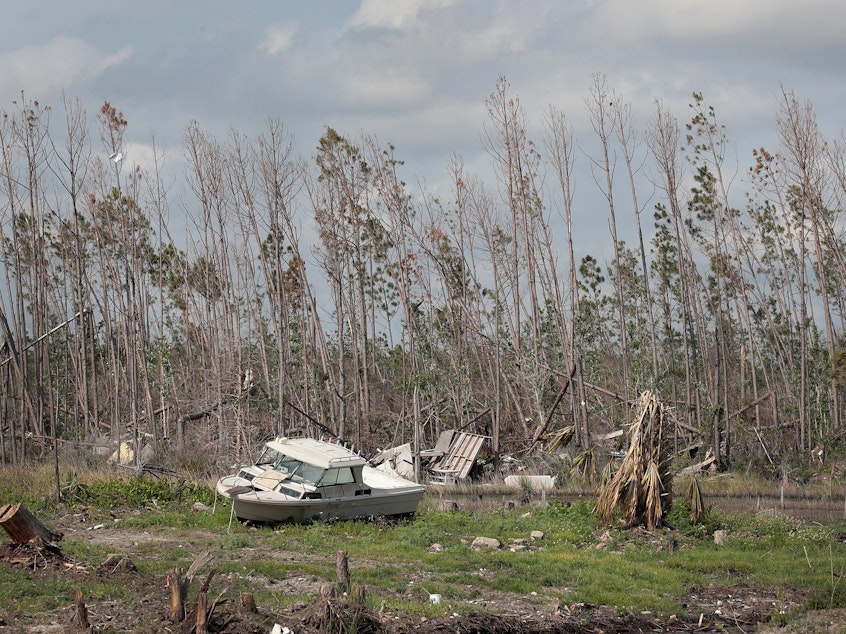'Everyone Would Have Left': Putting Lessons From Hurricane Michael To Work

As another hurricane season begins, emergency managers and other officials throughout the Southeast and along the Gulf Coast are applying lessons they learned last year during Hurricane Michael. Those lessons include how they conduct evacuations.
Michael was a Category 5 storm ripped through Florida's panhandle with 160 mile per hour winds. The night before it made landfall, Lynn Haven, Fla., Mayor Margo Anderson was in the city's administrative building preparing to ride out the storm. The National Hurricane Center warned Michael was strengthening and was now likely to come ashore as a Category 4 storm with winds over 150 miles per hour. She went on Facebook Live with a message for the town's 20,000 residents. "If you are in a house that you don't think will take sustained winds of 100 miles per hour for several hours tomorrow," she warned, "you still have time to go to a shelter."
As it turned out, Anderson and other officials in the city's administrative building should have followed that advice. A temporary pavilion now occupies the ground where the administrative building stood. Showing a picture on her cell phone, Anderson points out "the hallway where myself and the 40 members of the police department ... ended up at the end of the storm."
The roof of the building where they sheltered is gone. Debris is everywhere. Insulation and wires hang down from the ceiling. A concrete building, she says, and Michael "ripped it away around us. We survived in the last standing hallway." The brick and concrete building, built in 1928, was reduced mostly to rubble. Nearly every building in Lynn Haven suffered severe damage. More than 250 homes were completely destroyed.
Now, eight months later, Mayor Anderson says with better information and a bit more time, she would done things differently. "Had we known it was going to be a Category 4 before we did, then everyone would have left," she says. "If I had known that it would strengthen and we had that kind of forecast before it came ashore, I would have had my police and fire [departments] evacuate as well."
For emergency managers in charge of evacuations, there's a well-worn adage: hide from wind; run from water. That's because the vast majority of deaths in hurricanes are of people who drown in flooding, including storm surge. Because of that, as Michael approached the Panama City area, Joby Smith, the chief of emergency management in Bay County says evacuations were ordered mostly for areas near the water. He says, "Storm surge is what most evacuation models are based on. And we also take into consideration though within our walls here, what do the winds look like?"
Because of last minute warnings that Michael might intensify, Bay County increased the areas under mandatory evacuation. A traffic assessment done after the storm suggested just 1/5 of the county residents ordered to evacuate actually did so.
In Mexico Beach, Fla., the community where Michael made landfall, the percentage of those who evacuated was much higher. Only 50 people were known to have been there at landfall. Jay Baker, a researcher and retired Florida State University professor who studies hurricane evacuations says, "Police went door-to-door in Mexico Beach. Now it's a small community. But that is by far the most effective way to disseminate evacuation notices."
Unfortunately, three of those who remained in Mexico Beach died in the storm surge. Elsewhere, several people died after being hit by falling trees or debris. Baker says that's one of Michael's reminders: high winds also kill. "I do think that there are a lot of people ... reassessing whether or not it's advisable to stay behind if you're going to have winds like this," Baker says. "A lot of the damage that was done wasn't to wind just blowing houses away. It was blowing big trees down onto houses."
Two people died during the storm in Jackson County, a rural area more than 40 miles from the coast with just 50,000 residents. Mandatory evacuation was ordered for people who live in mobile homes, which is almost a third of the county. But the director of emergency management in Jackson County, Rodney Andreasen says even those who lived in permanent wood or stone structures weren't safe. He says, "We saw a lot of the older buildings, brick buildings in town that collapsed and were destroyed. Some others were heavily damaged just from the wind, collapsing. The building next to us, it just came apart."
Andreasen says buildings on Florida's panhandle simply aren't designed for winds like those seen in Hurricane Michael. He says, "I think it's woke up a lot of people to that fact. And we're going to start seeing a lot of things change because of that."
Among those likely changes: how people prepare for storms, how many evacuate and how strong new construction on Florida's panhandle will need to be to survive hurricanes like Michael. [Copyright 2019 NPR]



